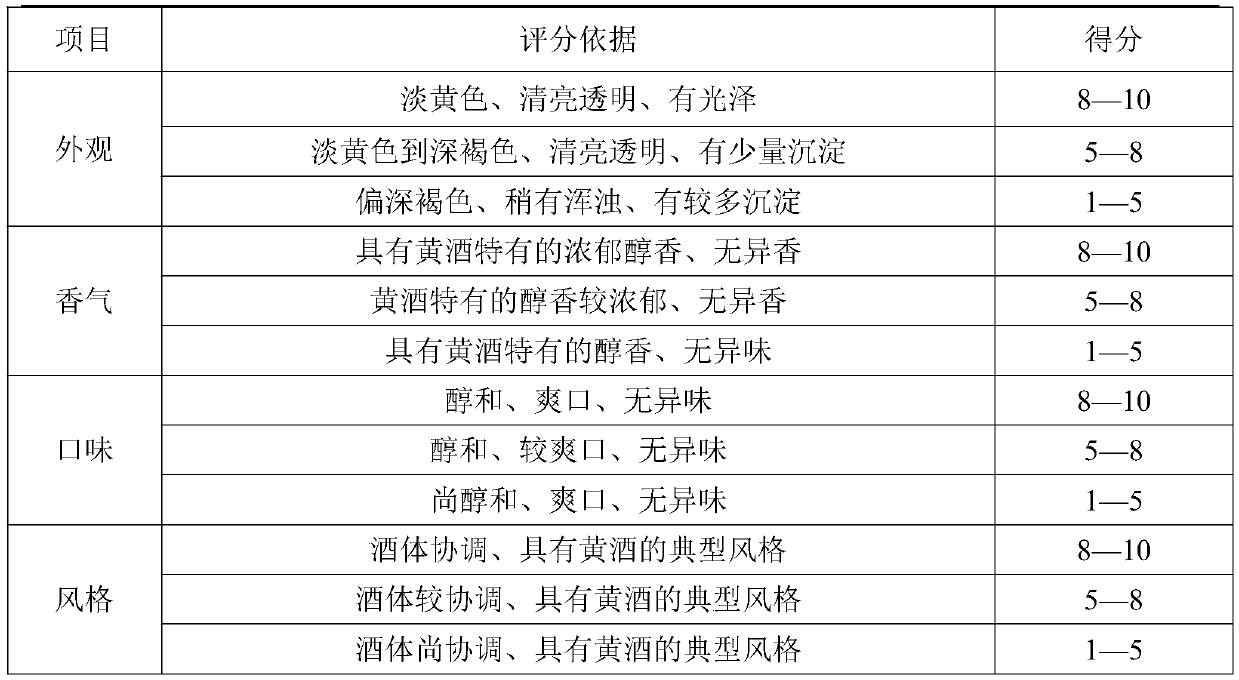Method for co-producing yellow rice wine and table vinegar by utilizing dendrobium nobile
A technology for joint production and rice wine, applied in the field of food condiments, can solve the problems of high energy consumption, low yield, acetic acid volatilization, etc., and achieve the effects of reducing the generation of solid waste, improving economic benefits, and being environmentally friendly.
- Summary
- Abstract
- Description
- Claims
- Application Information
AI Technical Summary
Problems solved by technology
Method used
Image
Examples
Embodiment 1
[0035] A kind of method utilizing dendrobium to jointly produce dendrobium rice wine and dendrobium vinegar is realized by following method:
[0036] 1) Pulverization: take the dry strips of Dendrobium candidum, grind them into 0.4cm long particles with a pulverizer.
[0037] 2) Soaking: mix Dendrobium officinale grains and rice at a mass ratio of 1:5, add water twice the total mass of Dendrobium officinale grains and rice and soak for 4 hours.
[0038] 3) Cooking: put the fully soaked dendrobium grains and rice in a steamer at 100°C for 30 minutes.
[0039] 4) Cooling: Take out the cooked mixture and spread it out to below 35°C.
[0040] 5) Mixing koji and saccharification: put the cooled material in a pottery jar, mix in wheat koji (purchased from: Jiangsu Boli Biological Products Co., Ltd.), the amount of wheat koji added is 5% of the mass of dry dendrobium and starchy raw materials , the addition of amylase, pectinase and cellulase is 0.15% of the total mass of rice and ...
Embodiment 2
[0046] A kind of method utilizing dendrobium to jointly produce dendrobium rice wine and dendrobium vinegar is realized by following method:
[0047]1) Pulverization: take dry strips of Dendrobium officinale, Dendrobium Huoshanense and Dendrobium nobile, the mass ratio of which is 1:1:1, and crush them into 0.2cm-long particles with a pulverizer.
[0048] 2) Soaking: Mix the dendrobium grains and rice at a mass ratio of 1:8, add water three times the total mass of the dendrobium grains and rice and soak for 8 hours.
[0049] 3) Cooking: put the fully soaked dendrobium grains and rice in a steamer at 121°C for 15 minutes.
[0050] 4) Cooling: Take out the cooked mixture and spread it out to below 30°C.
[0051] 5) Mixing koji and saccharification: put the cooled material in a pottery jar, mix in wheat koji (purchased from: Jiangsu Boli Biological Products Co., Ltd.), the amount of wheat koji added is 10% of the mass of dry dendrobium and starchy raw materials , nest saccharif...
Embodiment 3
[0057] 1) Pulverization: Take dry strips of Dendrobium officinale, Dendrobium purple, Dendrobium Huoshanense and Dendrobium nobile, the mass ratio of which is 1:1:1:1, and crush them into 0.3cm-long particles with a pulverizer.
[0058] 2) Soaking: Mix the dendrobium grains and rice at a mass ratio of 1:6, add water three times the total mass of the dendrobium grains and rice and soak for 6 hours.
[0059] 3) Cooking: put the fully soaked dendrobium grains and rice in a steamer at 110°C for 20 minutes.
[0060] 4) Cooling: Take out the cooked mixture and spread it out to below 30°C.
[0061] 5) Mixing koji and saccharification: put the cooled material in a pottery jar, mix in wheat koji (purchased from: Jiangsu Boli Biological Products Co., Ltd.), the amount of wheat koji added is 15% of the mass of dry dendrobium and starchy raw materials , build a nest for saccharification, the addition of amylase, cellulase and pectinase is 0.10% of the dry weight of rice and dendrobium, t...
PUM
 Login to View More
Login to View More Abstract
Description
Claims
Application Information
 Login to View More
Login to View More - R&D
- Intellectual Property
- Life Sciences
- Materials
- Tech Scout
- Unparalleled Data Quality
- Higher Quality Content
- 60% Fewer Hallucinations
Browse by: Latest US Patents, China's latest patents, Technical Efficacy Thesaurus, Application Domain, Technology Topic, Popular Technical Reports.
© 2025 PatSnap. All rights reserved.Legal|Privacy policy|Modern Slavery Act Transparency Statement|Sitemap|About US| Contact US: help@patsnap.com



